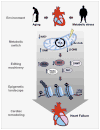Epigenetic regulation in heart failure
- PMID: 27022893
- PMCID: PMC4955576
- DOI: 10.1097/HCO.0000000000000276
Epigenetic regulation in heart failure
Abstract
Purpose of review: This article provides an overview, highlighting recent findings, of a major mechanism of gene regulation and its relevance to the pathophysiology of heart failure.
Recent findings: The syndrome of heart failure is a complex and highly prevalent condition, one in which the heart undergoes substantial structural remodeling. Triggered by a wide range of disease-related cues, heart failure pathophysiology is governed by both genetic and epigenetic events. Epigenetic mechanisms, such as chromatin/DNA modifications and noncoding RNAs, have emerged as molecular transducers of environmental stimuli to control gene expression. Here, we emphasize metabolic milieu, aging, and hemodynamic stress as they impact the epigenetic landscape of the myocardium.
Summary: Recent studies in multiple fields, including cancer, stem cells, development, and cardiovascular biology, have uncovered biochemical ties linking epigenetic machinery and cellular energetics and mitochondrial function. Elucidation of these connections will afford molecular insights into long-established epidemiological observations. With time, exploitation of the epigenetic machinery therapeutically may emerge with clinical relevance.
Conflict of interest statement
None declared.
Figures

References
-
- Hill JA, Olson EN. Cardiac plasticity. The New England journal of medicine. 2008;358(13):1370–1380. - PubMed
-
- Rich MW. Heart failure in the 21st century: A cardiogeriatric syndrome. The journals of gerontology Series A, Biological sciences and medical sciences. 2001;56(2):M88–96. - PubMed
-
- From AM, Leibson CL, Bursi F, Redfield MM, Weston SA, Jacobsen SJ, Rodeheffer RJ, Roger VL. Diabetes in heart failure: Prevalence and impact on outcome in the population. The American journal of medicine. 2006;119(7):591–599. - PubMed
-
- Kenchaiah S, Evans JC, Levy D, Wilson PW, Benjamin EJ, Larson MG, Kannel WB, Vasan RS. Obesity and the risk of heart failure. The New England journal of medicine. 2002;347(5):305–313. - PubMed
Publication types
MeSH terms
Substances
Grants and funding
LinkOut - more resources
Full Text Sources
Other Literature Sources
Medical
Research Materials

